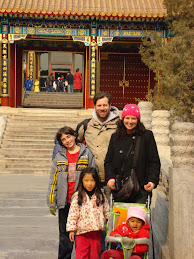
In south western Fuijian province, about 4 hours from Xiamen, is an area with a heavy concentration of Hakka people. They are not exactly an ethnic minority, but are a group of Han Chinese who had to migrate from the north of China about 1000 years ago and settled in Fujian province, where they were not always welcome, since farmland and other resources were scarce in this very mountainous area. Eventually they developed a style of building which is quite striking, using rammed earth and bamboo, as well as other home-grown materials such as glutinous rice to construct huge earth dwellings, most of them round (hence the term roundhouses). The University sponsored an overnight trip this weekend to see some of these buildings which are still in use by the local people. The first thing we were struck by was the enormous size...they can house entire clans together, up to several hundred people. They were built with no first floor windows "to keep out the tigers" according to the guide, and also to withstand hostile attacks by neighbors. Like all good tour groups, our first stop was lunch next door -- very simple local food, lots of pork, unidentified greens and some glutinous rice dumplings and sweets.

Also, its persimmon season and these were drying everywhere in the village, and being sold all over (we had just tried our first ones in Xiamen earlier in the week). Kind of like a sweet potato in flavor.


This was a wedding procession -- I am pretty sure it was staged for the tourists, but still colorful.

Inside the largest tulou, we found a lovely, peaceful atmosphere. The day was quite hot for December and we were all overdressed, but the tulou was cool. It has its own water supply by well, pictured above..with one well int the east and another in the west, which has some kind of fen shui significance. Our guide was very into the notion that the tulou have ideal feng shui, as well as natural heating and cooling because they are made of earth.

This large tulou was built in 1912, so it is quite new. It was built by a man who had become wealthy raising and trading tobacco. The interior was constructed beautifully of wood, and I found the circular interior very pleasing to the eye, and crying out to be photographed. The tulou is jointly owned by a group of relatives, and the guide said that since the tourists have begun to flow, competition for tourist money has disrupted the harmony of some of the extended families who live here. Also, many of the residents only spend a few weeks a year (usually at the Spring Festival) living in the village, because they need to pursue work in the cities.


We had the best time just wandering around this village. It is the off season for tourists, and we had the place pretty much to ourselves. This small shrine to a local deity was in the village square.

In the right background you can see the smallest of the four tulou in the village.

The river which ran through the village was really its defining feature. One of the other professors (an Australian marine biologist working to improve watershed health in China) on the trip remarked that it seemed to be a pretty healthy river by Chinese standards.

A woman was washing her green vegetables in the river and leaving them to dry along the bridge. We had lunch here so for her sake and ours I hope he was right!


One of the university staffers brought her 2 year old so our kids weren't the only ones.. they had a good time together, and my Chinese was just about on the two year old's level!



The focal point of the clearing in the village was a huge Banyan tree.

After a full day we were whisked away to a 4 star hotel in the big city of Longyan, about 90 minutes away. I was a little disappointed because we had seen a tulou set up as a simple inn where you can spend the night, and wanted to prolong the stay there...maybe we will go back again and do that.

Tomorrow I will bring you up to date on the rest of the trip -- 1000 steps up Guanzai mountain -- Sophia did about 500 of them herself!





4 comments:
Amazing!
can you tell me the name of that Aka village? I want to go there, but since there are more than one...thanks
Yes, please give us more information on the location of this village. Thanks!
I googled 'toulou' since it was posted on Yahoo as one of the world's most amazing dwellings. I was thrilled to see your photos. Yes it would have been wonderful to have stayed overnight in one.
Post a Comment